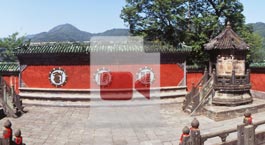Divine views from Golden Summit
By Erik Nilsson
Updated: 2009-11-12
 |
|
The snow-capped Golden Summit is the peak attraction of Wudang Mountains, in Hubei province. |
While the story of Zhen Wu's transformation into an immortal may be a myth, the Taoist's undying legacy has had a real impact on Wudang Mountains.
This ancient saga has made the mountain range in today's Hubei province a place of pilgrimage for contemporary believers of archaic China's only native religion. And the area's magnificent scenery, fascinating folklore and indigenous kungfu lure travelers of other theological persuasions, too.
The peak attraction in Wudang is Jinjian (the Golden Summit), which shines as the alpine range's highest and most sacred point.
Visitors reach the 1,612-m-high apex by taking a 25-minute ride on a 1.51-km-long cableway from Chongtai. This location partway up the mountain is where Zhen Wu is said to have transmuted into a god more than two millennia ago. Rugged types can take on the three-hour slog up the alp, before trudging for two hours back down.
As various emperors ordered the construction of several temples on the summit over the centuries, the pinnacle took on the shape of an enormous tortoise tussling with a gargantuan serpent.
The compound of buildings enclosed by Divine General Wang's Wall form the animal's shell, while one of the nine rocky protrusions near the summit is the creature's head. Leading up to these structures is a zigzagging set of 168 stone steps, which form the "snake's body". In Chinese, the number represents "yi lu fa", which means, "to become wealthier".
General Wang, the guardian of Taoism whose statue is set in one of the shrines along the wall, is rendered with a long beard and three eyes. He is clad in a crimson robe worn beneath golden armor and brandishes magical charms in his left hand.
The construction of holy edifices on the Golden Summit began with an order from Tang Dynasty (AD 618-907) Emperor Li Shimin (626-649).
When drought baked his lands, the ruler sent ministers to many sacred mountains around the empire to pray for rain. But it was only after court official Yao Jian went to Wudang Mountains and invoked Zhen Wu, who became the Taoist water deity upon attaining immortality, that downpours came.
So the ingratiated emperor ordered the construction of Wolongsi, the area's first temple.
More sacred edifices were built in the Yuan Dynasty (1271-1368), including the Turnaround Palace, originally erected at the very highest point and relocated further down the slope in the Ming Dynasty (1368-1644).
Visitors to this venerated hall squeeze into a cramped, dark corridor surrounding a shrine of Zhen Wu that is walled-in on three sides. With their bodies squished between the back walls of the temple and those of the shrine, they must walk sideways, feeling their way through the inky blackness to encircle the sacred statue.
When they pop out into the light on the other side, they will have earned good fortune.
The Turnaround Palace was relocated during the Yongle Period (1403-1425) of the Ming Dynasty, when Wudang Mountains took on new prominence.



